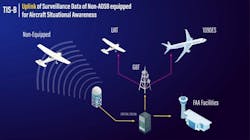In recent months, the aviation world has been shaken by a series of accidents underscoring the critical need for robust safety awareness and compliance. These tragedies also serve as a stark reminder to general aviation airport sponsors and operators of the need to continually reassess and strengthen their culture of safety.
To enhance safety and prevent accidents, last spring the Federal Aviation Administration (FAA) mandated that airports, charter airlines, commuter airlines, air tour operators and certain aircraft manufacturers have a Safety Management System (SMS). This requirement has been in place for U.S. airlines since 2018.
Historically, aviation safety relied on reactive measures—analyzing past accidents to implement corrective actions. While this approach has contributed to significant safety improvements, it often addresses issues only after they have resulted in incidents.
In contrast, a SMS offers a proactive framework, enabling organizations to identify potential hazards, assess associated risks and implement mitigation strategies before incidents occur. A key component of an effective SMS is fostering a positive safety culture. What does this mean?
The terms “safety management” and “safety culture” are often used interchangeably. However, they each serve specific purposes. Think of safety management as the foundation that provides a strong, stable base to support the safety culture. The safety culture then reevaluates and repairs the foundation of safety management.
Both safety management and safety culture are intended to mitigate injuries and promote safe working habits. Both also utilize a commitment to continuous improvement to make workplaces safer. They function best when they operate synergistically to create a whole safety program. A strong safety culture is characterized by:
· Open Communication: Encouraging the reporting of hazards and safety concerns without fear of reprisal.
· Shared Responsibility: Ensuring that all members of the organization, from senior management to line staff, are committed to safety.
· Continuous Improvement: Regularly reviewing and enhancing safety practices to adapt to new challenges.
Creating a strong safety culture requires the engagement and commitment of an organization’s entire workforce. Leadership plays a crucial role in setting the tone and fostering an environment where employees feel safe to think critically, ask questions, provide recommendations and report safety hazards without fear of reprisal.
A healthy and proactive safety culture empowers every team member to take ownership of safety. When revisiting your organization’s safety culture, consider these core questions:
· Do you have an open and non-punitive hazard reporting system?
· Do all employees feel invested and protected in the shared responsibility of keeping each other – and the equipment they maintain and operate – safe?
· Are identified hazards properly assessed and addressed with appropriate root cause analysis and corrective action?
It has been demonstrated that maintaining strong safety management – overseen by a trusted safety culture where voluntary reporting is encouraged – can result in reduced accidents and incidents, more efficient workflows and a more loyal employee base. However, this process often presents significant challenges.
Tenants and operators must ensure sufficient time, personnel and financial resources are dedicated to safety initiatives. They may also face resistance to change as they strive to align safety goals with organizational objectives. Additionally, they must uphold a strong commitment to safety practices amid mounting operational, community and political demands.
A significant challenge arises when political and community pressures—such as concerns over aircraft noise, emissions and air quality—risk diverting focus and resources from critical safety initiatives. While it is essential to address these concerns and engage with all airport stakeholders, airport sponsors and operators must remain steadfast in prioritizing safety above all else.
A well-implemented SMS can serve as a vital tool for educating elected officials and community members about the importance of investing in essential safety infrastructure, as well as the potential unintended consequences of diverting attention away from essential risk mitigation efforts.
A clear example of how shifting airport financial, maintenance and improvement priorities can affect aviation safety is the evolving use of Automatic Dependent Surveillance–Broadcast (ADS-B) technology. Originally implemented in 2020 to enhance flight safety and efficiency, ADS-B was designed to improve situational awareness, reduce the risk of midair collisions and streamline air traffic management. However, its application is expanding beyond these safety-focused purposes.
Recent developments suggest the system is being leveraged for legal actions, enforcement measures and the collection of landing fees. This shift has raised concerns that expanding the role of ADS-B may compromise its core purpose as a safety tool and cause pilots to face future advancements in aviation technology with skepticism. However, these issues are different at their core: one relates to FAA actions, one is a privacy concern and the other is a natural and legitimate use for airport/aviation safety.
In light of this issue, last year’s FAA Reauthorization sought to ensure ADS-B technology would be used only for its original purpose. However, regardless of any legislative process, pilots must remain fully responsible for maintaining safe flight operations. And, the aviation industry must remain receptive to using technologies that improve efficiency and reduce costs.
It is clear that the use of ADS-B technology for tracking aircraft to collect landing fees should never come at the expense of aviation safety. However, using efficient technology to collect rates and fees can contribute to a healthy airport eco system – maximizing return on airport projects aimed at improving operational safety and financial viability.
Airports do face significant financial pressures, particularly when traditional Airport Improvement Program and discretionary funding are limited. They should prioritize transparent budgetary processes and commit to exploring alternative revenue strategies – such as flowage fees and new airport aeronautical and non-aeronautical development.
Additionally, airports should focus on maximizing airport assets through reasonable fees and leasing opportunities. This includes landing fees where the stakeholders, users and airport collectively evaluate all airport operating and capital requirement costs that may warrant them.
In its recent General and Business Aviation Call to Action, the FAA identified concrete steps to address recent safety incidents and make the industry safer. In addition to VFR/IFR Interactions and safety drift, safety management emerged as a key factor that is scalable to all types of aviation operations.
A strong safety culture is not just a regulatory requirement, it is the backbone of aviation. When organizations prioritize safety, they reduce risks, improve efficiency and foster trust among airport stakeholders.
Maintaining this commitment requires vigilance, particularly when external pressures threaten to shift focus away. The evolving use of ADS-B serves as a cautionary example. Industry and FAA leaders should work together to preserve opportunities for using this technology, while considering privacy, safety and efficiencies that can best assure results.




